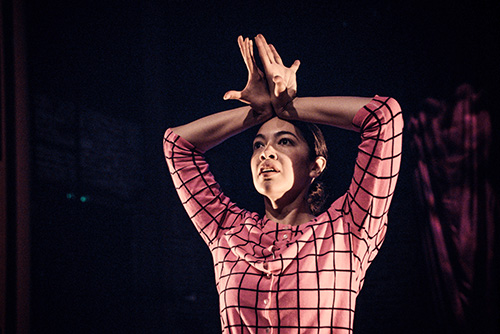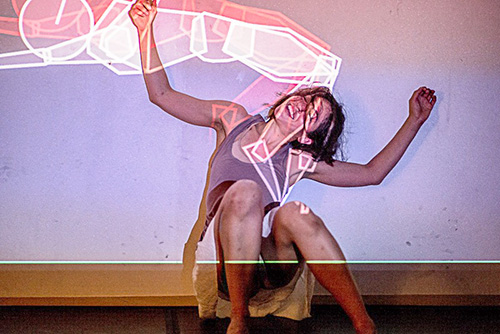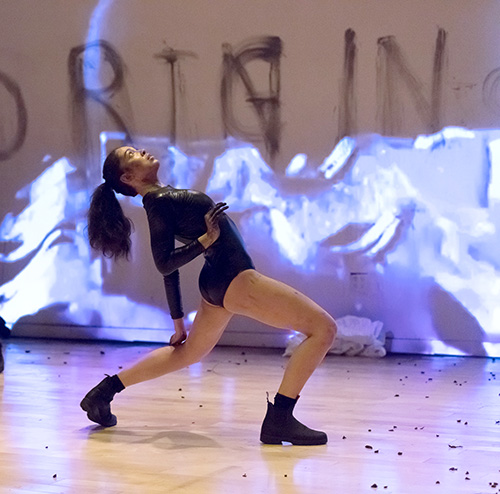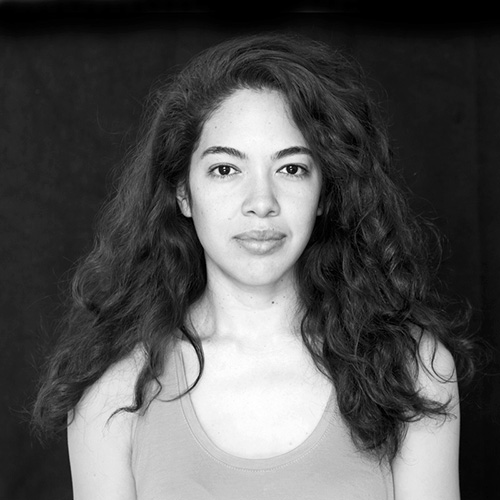Expanding Experience
An Interview with Karla Quintero
BY EMMALY WIEDERHOLT
Karla Quintero is a dancer and choreographer in the San Francisco Bay Area. As part of a special dialogue in honor of National Hispanic Heritage Month, Karla discusses the importance of granting institutional support to myriad communities and challenging individual habits of viewership.
Photo by Robbie Sweeny
~~
When you’re choreographing, do you work from a political, social or personal place, or a mix?
Content-wise, my choreography derives from the personal and whatever my personal relationship is to either my own identity or other people. I’ve spent most of my life living in an urban environment, so I frequently observe other people and their behaviors, mannerisms and interactions. My content often comes from these nuggets and where they take my imagination.
As far as structure, I’m currently interested in immersive small-scale performances. I have a residency at Shawl Anderson Dance Center, and I’ve been researching ways to build a performance for an audience of one to three people. I’m trying to blur the line between being an observer and participant in a way that’s natural, not effortful, and emerges from the choreography. This interest comes from my craving for shared human experiences and interactions that are not based on what we say. I believe the shared embodied moment is particularly important right now. I want to have exchange, but in a nonverbal way.
Is it important to you to be recognized as a Hispanic/Latina or female choreographer, or do you see the modifiers as a form of tokenism?
Both identities are important to me. Claiming the title of Latina choreographer is important because there’s so much I draw from my heritage, both in terms of performance and practice. My mom is from Nicaragua and my dad is from Colombia, and I grew up in an immigrant community in New York. In my experience, I feel like people from the Latina culture don’t hide anything; they just sit in whatever they are feeling without a value judgement, whether it’s vulnerability, aggression, etc. It doesn’t seem to get hidden or bottled up. I try to bring this openness into my practice and performance, and I think it’s important to reference that’s where it comes from.
If I try to think of highly visible Latina choreographers in the US, I can’t think of many, especially women. So yes, I think it is important to say I’m a female and Latina choreographer, so people know we’re out there. It doesn’t necessarily have to be heavy advocacy, but just to show the spectrum of people who are making dance.
Photo by Weidong Yang
In your experience, do you feel there are enough opportunities for Hispanic/Latina dance artists, or would you like to see more?
I don’t think there are enough. I think there’s a lot of dialogue around diversity, but not enough actions that really reflect value. If you’re working on the foundation level or for an agency that’s giving government grants, then it’s your job to address what different communities are asking for, instead of just getting bogged down within the bureaucratic structure. With grants, there’s an evaluation process that attempts to prove the value of work, but that doesn’t always serve work coming from under-supported communities. Look at who you’re funding and how much money they’re getting.
With regards to the institutions that are wanting to support a more diverse spectrum of artistic voices, I feel it’s also important for them not to place limits or set expectations for how these artists’ works reference their cultural heritage and identities. For example, when I come across opportunities targeted for Latina artists, I get the sense there are implicit expectations about what creative expression should look like for a Latina – limits on themes the work can explore, and the shape and purpose of the work itself.
A few years ago, I was fascinated by humanity’s efforts to reach Mars and so I made a piece about it. While my perspectives on this subject, and my very interest in the matter to begin with, have very much to do with my cultural and socio-economic background, do funders targeting Latina artists care to hear what a Latina artist has to say about Mars? Or are they only interested in works that reflect this heritage in more obvious or stereotypical ways?
What are some changes you’d like to see that would create better representation of Hispanic/Latina voices?
On a personal level, if I want to see new and different voices in dance, then it’s my responsibility as an individual to go see shows where I don’t know anyone in the performance, or check out venues I’ve never been to, and let the work resonate without a value judgement.
Pick up a newspaper and find something new. Afterward, reflect on the experience. Don’t worry if you don’t “get it.” If you don’t have a frame of reference, the choreography might not resonate right away. And if you don’t know anything about what you’re going to see, maybe do some online research first. Push yourself to get more out of new experiences.
On the dancer side, if, for example, you’re always dancing with people who are the same age, ask someone who’s older or younger to come into the studio. There are basic things each of us can do to start to expand our experiences. But it takes a lot of time, and it’s not easy. Change is slow.
Photo by Margo Moritz
What’s your background in dance? Did you ever feel like your heritage was incongruous with your dance training?
Through high school, I danced once a week at a local dance school, taking ballet, jazz and tap. In college, I went to Ballet Hispanico for a summer program, and this was the first time I experienced dancing every day. From there, I decided dance was something I wanted to experience more of. I was at Ballet Hispanico for about a year before I quit. I worked in New York and danced on the side for a few years before auditioning and being accepted at SUNY Purchase. Afterward, I moved to San Francisco. In the Bay Area, I take ballet, modern, contemporary, release, Feldenkrais and somatic modality classes, depending on what I need.
I definitely am cognizant of the fact that most people in modern/contemporary dance classes are white and not from a lower income background. I’m a little less emotionally affected by it though because I wasn’t exposed to it as a kid. At my neighborhood school, everybody came from different backgrounds. It was just about building friendships and learning discipline. It was a very supportive environment, and it taught me that dance training could be a very positive experience for anyone.
When I went to Ballet Hispanico and was confronted for the first time with dance teachers’ demands and reverence for lean body types, it felt absurd. At Ballet Hispanico, what I found most incongruous with my upbringing was some of the teachers’ lack of curiosity about the students’ diverse goals. While some students were trying to dance in a traditional company, many teachers didn’t attempt to find out the dance goals of their students beyond those few. The biggest divide for me occurred when dance teachers didn’t know how to provide rigorous formal dance training while taking into consideration the different paths students might take.
What do you hope is your contribution to the dance world?
It would make me happy if the people who come to my small-scale immersive performances feel like they’re able to lose their sense of self. For example, fear of invading personal space is common in American culture. Transforming that fear would be really great.
If someone came to a performance, rehearsal, or even had a conversation with me and, as a result, became more interested in dance in general and started to see other work on their own, or became less fearful of the ambiguity of seeing live performance, that would make me really happy.
Photo by Marco Prenninger
~~
To learn more, visit karlajohannaquintero.tumblr.com.





One Response to “Expanding Experience”
Eres bella por fuera y por dentro TE AMO KUKLA!!!!!!
Comments are closed.